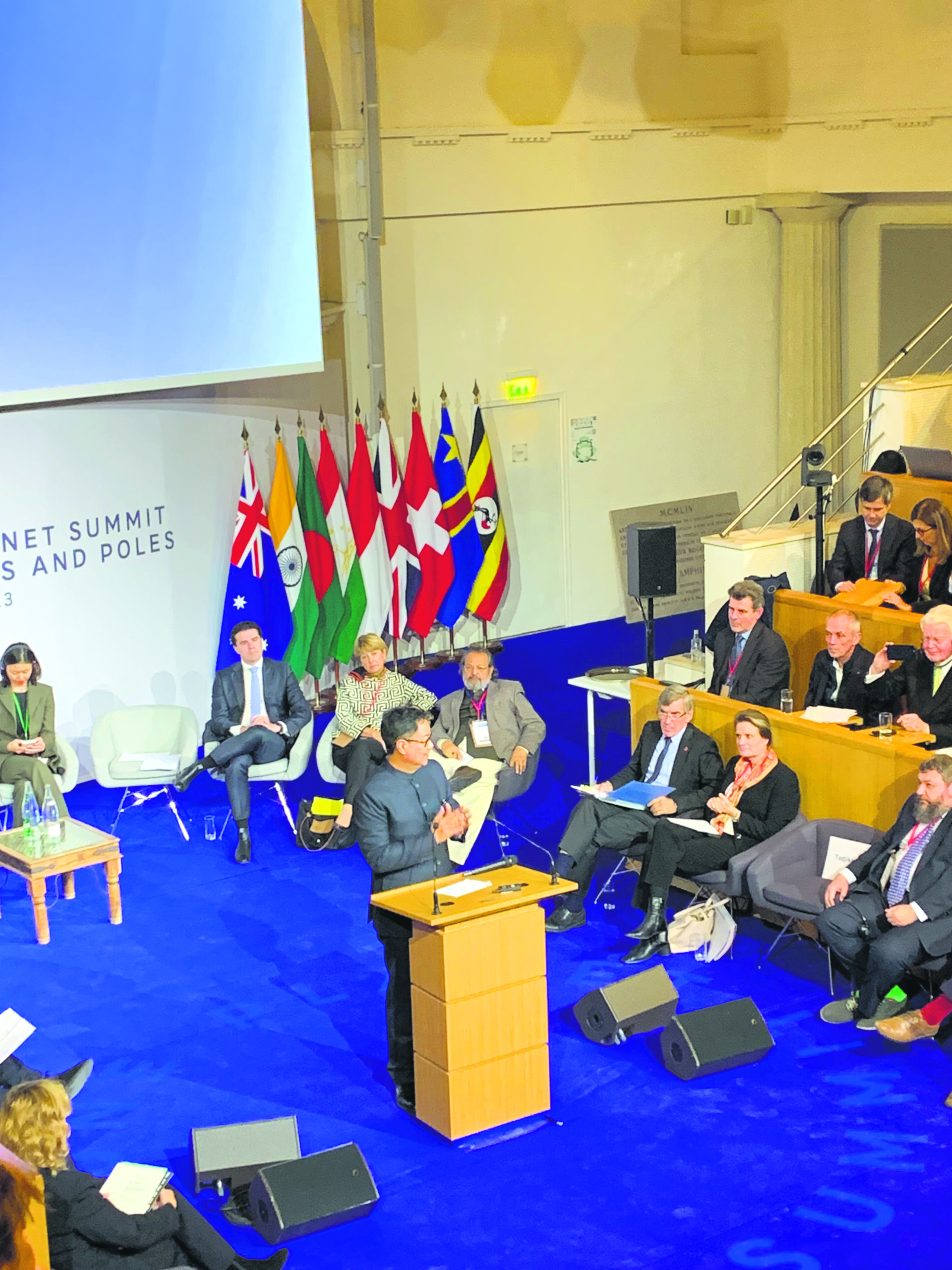A city-wise connect across regions and borders, binding the smaller cryospheric settlements in a lattice of synergised needs, will assist in alleviating the governance gap.
NEW DELHI
The world is seeing many firsts when it comes to climate negotiations. Considering the magnitude and the rapidity of these changes, it is understandable that global meets matter. Strangely enough, however, discussion forums end with interesting posturing unsubstantiated by action. The ongoing COP28 is already embroiled in leaked reports and speculations about UAE’s fossil-fuel deals with several of the 80-odd nations attending, which stands in the direct juxtaposition of the conduct and the content of a climate meeting. The freshly initiated One Planet Polar Summit organised by France earlier in November this year, a precursor to the COP28, focused on fast disappearing shared spaces in a backdrop of rivalry and competition, hoping to bind nations and communities into a matrix of political earnestness.
The Paris Polar Summit’s three components, scientific, policy and civil society, drew from landscape postulations, distilling the presentations into a Declaration delivered by French President Emmanuel Macron in the historic Savanna-march backdrop of Paris’ Natural History Museum and signed by 32 nations. The scientific body reiterated IPCC’s findings about the cryosphere, addressed as a special report post AR5 and for the first time as part of AR6, stating unequivocally that the Poles and the mountain glaciers are melting faster than any other space on planet Earth. The Paris Declaration, therefore, calls for 2025-2035, a critical period in the history of the planet’s cryosphere, to be dedicated to the study of the Poles. The extent of this loss can be comprehended from UNESCO’s 2017 Ice Memory Initiative, where libraries of fast-depleting glaciers are being locked away safely (for the moment) in Antarctica for future scientific endeavours.
While the Paris declarations were well received by many nations, including India and its neighbours Nepal, Bangladesh and Pakistan, Norway shied away from signing amid speculation about its intent for deep sea mining in the High-North, as did all other seven Arctic nations of Iceland, Finland, Sweden, Canada, US (Alaska), Denmark (Greenland) and Russia. Considering that the Arctic was at the centre stage of the Paris Polar discussions, it was remarkable that even the three EU partners from the Arctic chose to stand outside of a call initiated by France. The impasse may be remedied in the next One Planet-Polar Summit, likely to be organised by an Arctic Council state, Iceland. While Russia went unrepresented, China’s scientific advisory board member’s pre-recorded video added no new perspective, leaving India’s heavyweight participation through its ministerial delegation to stand apart.
India’s Minister for Earth Sciences, Kiren Rijiju, speaking at the many forums of the event, highlighted India’s Polar endeavours and pledged India’s full cooperation towards shared global challenges. Warmly enveloped in French hospitality, the minister spoke about the need for a robust Third Pole engagement.
While there is uncertainty in science and a gap in observational networks, especially in the Himalayas, we know enough to involve, with urgency, the populace that inhabits these cold, marginalised spaces. The Himalayan communities, at the forefront of the climate crisis, with glaciers being the first responders of phenomenal change, have little say in the increasing fragility of the mountains. Unlike the Saami and other indigenous Arctic communities, the Himalayan tribes Apatani, Mishmi, Bhutia, Lepcha and other communities are ill-represented in national or even state-level governance. The challenges of sustainable development of the hazard-prone Himalayas need a three-pronged approach—better science, better governance and better interconnectedness.
Under India’s neighbourhood first policy, a Himalayan Science Council with a “Himalaya-first” outlook is imperative to offer a one-window solution to the region’s multi-institutional, somewhat discordant, science engagements. Although India’s BIMSTEC initiative interweaves a Himalayan component into a Bay of Bengal narrative, its scope covers a vast swath of issues, not strictly Himalayan.
Second, a city-wise connect across regions and borders, binding the smaller cryospheric settlements in a lattice of synergised needs, will assist in alleviating the governance gap. Glacial communities will find a voice in a structured and nuanced space, striving for innovative solutions arresting the loss of cultural ethos and identity as the protectors of the land. A city coalition, or in the case of glacial regions, a town coalition, presents a compact framework and offers greater hope for climate solutions.
While city coalitions for slums-free settlements and digital rights are underway, the first one to address climate change by linking coastal cities was under the aegis of the UN Ocean Conferences, with 2021-2030 mandated as the decade of the ocean. The experiences from such interconnections can help build a cryospheric experiment for community-level engagement.
As the world grapples with climate change, India, pivoted agreeably in the Global South, can rise to prominence by equalising access to Polar research. As remarked by a young student at the One Planet-Polar Summit in Paris, visa-free research in the Antarctic needs to be operationalised through multiple shared stations, open to all, for the good of all humankind. As host to the 46th Antarctic Treaty Consultative Meeting to be held in Kochi in May 2024, India can flag such egalitarian demands involving its neighbours and several other nations in the global south.
The world came together to phase out ozone-depleting substances through the Montreal Protocol despite stratospheric ozone not being an issue of concern for the tropics. The same must be done for carbon, which, unlike ozone, is found uniformly mixed in the atmosphere across the globe. While ozone is on its way to recovery, carbon emissions are still in the domain of bitter geopolitics, COP28 notwithstanding.
Dr Sulagna Chattopadhyay is President, SaGAA, Secretary General, LIGHTS and Editor-in-Chief, Geography and You.

